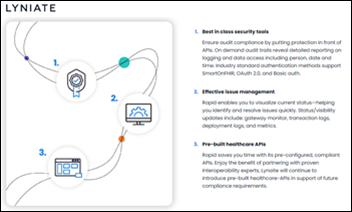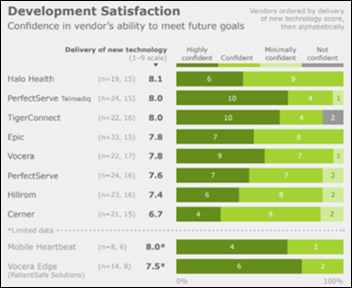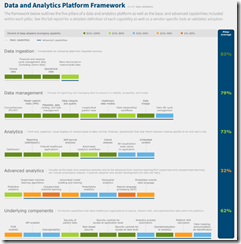News 10/1/21
Top News

Microsoft makes an unspecified investment in Truveta, the data-selling company that is owned by 17 big health systems. Truveta said in the same announcement that it has chosen Microsoft Azure as its cloud platform.
Microsoft says it won’t have access to Truveta’s de-identified data, but will integrate its platform into Microsoft Cloud for Healthcare.
Truveta’s member health systems have invested $100 million in the company, which launched in October 2020.
Truveta CEO Terry Myerson is a former Microsoft development EVP.
Reader Comments
From LinkedOut: “Re: LinkedIn user articles. Your gripes with LinkedIn should include providing a platform for people whose expertise and abilities don’t deserve one.” The Internet has made it possible for anybody to post an article, publish a book, or create a video or podcast, some of whom do so in the area of health IT. While some creative voices have rightfully emerged as a result, there’s a lot of junk out there that the publishing gatekeepers of old would have turned down immediately for good reason. Some of it finds an audience through persistence, omnipresent familiarity, or self-promoting gimmicks. I will let the market do its job in picking winners.
HIStalk Announcements and Requests
I looked at the leadership pages of three unrelated health IT vendor websites today while getting news information. Vendor A’s executive team had 12 older white guys and one young female VP of human resources. Vendor B’s page showed 10 less-wrinkly but equally white guys (it was a newer company), two female VPs (HR and marketing), and one female operational exec. Vendor C’s team was nine men and three female VPs (legal, HR, and an operational exec). Toss out legal, HR, and marketing VPs –diversity’s lonely outposts in many companies — and these three random companies had just two female operational executives of 34. I draw no conclusions except it struck me since I wasn’t looking for that information and these aren’t companies I actively follow.
Webinars
October 6 (Wednesday) 2 ET. “Solving Patient Experience Challenges Through a Strong Digital Front Door.” Sponsor: Avtex. Presenters: Mike Pietig, VP of healthcare experience, Avtex; Jamey Shiels, MBA, VP of consumer experience, Advocate Aurora Health; Chad Thorpe, care ambassador, DispatchHealth. Patients expect healthcare providers to offer them the same digital experience they get when banking, shopping, and traveling. This webinar will describe how two leading healthcare providers created digital front doors that exceed patient expectations, improve patient outcomes, drive loyalty and acquisition, and future-proof their growth strategies in competitive markets.
October 6 (Wednesday) 1 ET. “A New, Streamlined Approach to Documentation and Problem List Management in Cerner Millennium.” Sponsor: Intelligent Medical Objects. Presenters: Deepak Pillai, MD, physician informaticist, IMO; David Arco, product manager, IMO; Nicole Douglas, senior product marketing manager, IMO. The IMO Core CSmart app, which is available for Cerner Millennium in the Cerner code App Gallery, helps providers document with specificity, make problem lists more meaningful, and improve HCC coding. This webinar will review the challenges and bottlenecks of clinical documentation and problem list management and discuss how streamlined workflows within Cerner Millennium can help reduce clinician HIT burden.
Previous webinars are on our YouTube channel. Contact Lorre to present your own.
Acquisitions, Funding, Business, and Stock

Bloomberg News reports that Walgreens is considering the acquisition of care management technology vendor Evolent Health. EVH shares, which are up 133% in the past 12 months in valuing the company at $2.5 billion, rose on the rumor.

Weight loss app and telehealth vendor Found – which boasts that it allows bypassing doctor visits even though “obesity is a disease, not a decision” – raises $32 million in funding. The company offers prescription diet medications as well. I took its online questionnaire and it recommended the “Found Wellness,” no-meds plan at $49, which includes SMS-based coaching, weekly goal reminders, and community participation, adding up to one of the least-compelling offers I’ve seen. A business model that relies on overweight consumers who have failed in other weight loss programs to keep paying monthly fees for motivational text messages might warrant investor caution.
Intermountain Healthcare launches Tellica Imaging, whose standalone outpatient imaging centers will offer MRI and CT at flat-rate prices that are lower than hospital charges.

Cerner CEO-in-waiting David Feinberg, MD, MBA says he decided to leave Google Health because he wants to disrupt healthcare, improve lives, and affect healthcare quality and accessibility. He didn’t mention the $35 million compensation package that he gets for leaving the dismantled Google Health.

ED patient flow and status communications platform vendor Vital raises $15 million in a Series A funding round.
Sales
- UnityPoint Health’s home health services subsidiary chooses WellSky’s care coordination platform and personal care agency network as part of its SNF-at-home program.
- Powell Recover Center (MD) will implement Netsmart’s CareFabric platform, Netsmart network, and MyAvatar integrated EHR.
People

Fresenius Medical Care North America hires Shelly Nash, DO (AdventHealth) as SVP/CMIO.

I missed this last week: The Joint Commission names Jonathan Perlin, MD, PhD, MSHA (HCA Healthcare) as its next president and CEO. He has a strong background in informatics at the VA, HHS, and Vanderbilt University.

Release of information platform vendor Moxe hires Adam Dial (Providence) as SVP of partnerships.

Divurgent promotes Steve Weichhand, MBA to EVP of client service.
Announcements and Implementations

Lyniate launches Rapid, a healthcare API gateway and manager for developing and safeguarding APIs, including FHIR-based ones.
Augmedix will integrate Google Cloud Speech-to-Tex into its Notebuilder NLP-powered clinical note platform.
Nurx launches a birth control and sexual health knowledge skill for Alexa, which can provide pill reminders and answer questions.

A new KLAS report on clinical communications platforms finds that 100% of respondents reported improved communication efficiency, especially with regard to clinician collaboration. Top satisfaction in workflows went to Halo Health (which is being acquired by Symplr) and PerfectServe Telmediq; Hillrom (which is being acquired by Baxter) and Vocera lead in broad adoption; and satisfaction with delivery of new technology is highest with Halo Health and PerfectServe Telmediq. Customers of PerfectServe Telmediq and TigerConnect also note that the companies offer patient communication, while Vocera Edge is the only third-party solution that can support nurse documentation through bi-directional EHR integration.
COVID-19
CDC urges pregnant women to get vaccinated as COVID-related deaths during pregnancy reached 22 in August, the highest monthly total of the pandemic. Only 31% of pregnant women have been vaccinated.

A man who went to a freestanding ED in Texas for a COVID-19 test and is billed $56,000 in out-of-network fees, which his insurer eventually negotiated down to $17,000 and paid in full. Medicare would have paid just $100. The man’s wife was tested with him, but the ED company billed her just $2,000 and her insurance paid less than $1,000. Federal laws require insurers to cover the full cost without co-pays or other patient cost sharing.
COVID-19 is killing rural Americans at twice the rate of those who live in urban areas, with lower vaccination rates also causing already-limited healthcare services to be cut back as urban hospitals are unable to accept their transfers for higher-level care. Rural providers are also being hit by resignations of employees who refuse to be vaccinated despite mandates and their inability to afford the high hourly rates of nurse staffing companies. The head of the National Rural Health Association says nobody is addressing the issues and that “we’ve turned many rural communities into kill boxes.”
The New York Times reviews the use of at-home COVID-19 rapid tests, concluding that they will detect infections 85% of the time (with higher sensitivity when people are most infectious), optimal test timing is 3-5 days after known exposure or immediately if symptoms are present, and the tests give more accurate results if repeated a day or two after the first one. Challenges include a national shortage of the tests, the cost of $10-40 per test, and the inability of public health officials to track case counts unless someone who tests positive at home reports that fact to their local health authorities.
Documents obtained by The Intercept show that conservative-focused groups are spreading disinformation about COVID-19, then making millions selling their followers telehealth-powered prescriptions for ineffective treatments such as ivermectin and hydroxychloroquine. A hacked database from telehealth platform vendor Cadence Health shows that 281,000 patients – 90% of them referred from America’s Frontline Doctors and its telehealth partner SpeakWithAnMD.com – paid $6.7 million in just two months for consultations alone. The database of digital pharmacy operator Ravkoo was also hacked and showed that the company filled 340,000 prescriptions in 10 months for $8.5 million, with 76% of the prescriptions specifying hydroxychloroquine, ivermectin, zinc, or azithromycin. Both Cadence Health and Ravkoo have stopped doing business with the groups. At least one prescriber included a disclaimer in their consultation notes forcing patients to acknowledge that government agencies categorize the drugs as “highly not recommended” and that they will not be held personally responsible for adverse reactions and are not subject to criminal charges, malpractice lawsuits, or state medical board disciplinary actions. The hackers said that the websites of the recently created companies were “hilariously easy” to breach and may have violated HIPAA.
Sponsor Updates
- Frost & Sullivan recognizes Change Healthcare with its 2021 North American Customer Value Leadership Award for clinical decision support.
- Spok publishes its “2021 Report: The State of Healthcare Communications.”
- Gyant is among the 10 startups selected to participate in the inaugural AWS Healthcare Accelerator.
- Medicomp Systems releases a new Tell Me Where it Hurts Podcast with Iram Fatima, MBBS, COO of CareCloud.
- CareSignal publishes a white paper titled “Transform Your Population Health Strategy with Scalable Deviceless Remote Patient Monitoring.”
Blog Posts
- New Wave of Cyberattacks Has Hospitals Employing Secure Network Connections to Medical Devices (Capsule)
- Drip, Drip, Drip … That’s the Sound of Referral Leakage (Halo Health)
- Making Your EHR Work for You: 7 Roadblocks Faced by Healthcare Leaders (Healthcare Triangle)
- HCTec’s Patient Portal Support Shines During Pandemic Relief Efforts (HCTec)
- HAS 21 Virtual Wraps Up Three Days of Impactful Programming on Data and Analytics in Healthcare (Health Catalyst)
- We’re going strong and Inc. Magazine noticed again! (Health Data Movers)
- 5 Ways to Support Patients and Their Caregivers During COVID-19 (Healthwise)
- EXCEL Program Built to Support Clinicians (Optimum Healthcare IT)
- SMS Patient Reminders Improve Vaccine Uptake (Intrado)
- Side effects of an unhealthy surgical dictionary (Intelligent Medical Objects)
- Why the Hospital at Home Movement Needs AI to Succeed (Jvion)
- Closing the Online Scheduling Gap: Top 3 Opportunities for Health Systems (Kyruus)
- How you can tell when your black box, prebuilt healthcare API solution might be a mirage (Lyniate)
- CMS ECQM 2022 Update: Get Ready for New Glycemic Control Measurement (Medhost)
- Exploring the shift from transactional to transformational healthcare (Meditech)
- Providing a Better Patient Care Experience at Your Practice (MWTherapy)
- Addressing Inequities and Social Determinants of Health with Community-Wide Data Matching and Integration (NextGate)
Contacts
Mr. H, Lorre, Jenn, Dr. Jayne.
Get HIStalk updates.
Send news or rumors.
Contact us.





































You know what will radically improve patient lives? Universal healthcare, access to housing, paid childcare, better public transport. Improve a…